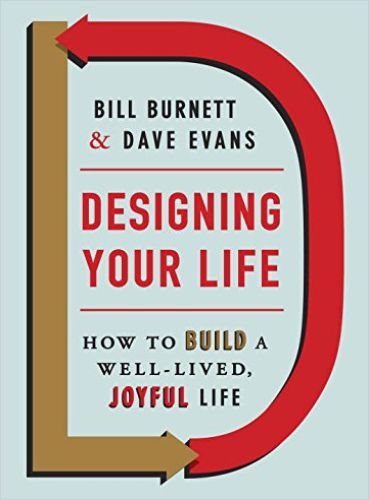Bill Burnett and Dave Evans’ bestseller teaches you how to reframe your view of yourself, your life, your mistakes, your likely future and your joy.

Reframing Failure
Bill Burnett, executive director of the Stanford Design Program, and Dave Evans, co-founder of Electronic Arts, offer a well-written, practical, witty and entertaining approach to improving your life.
The authors, co-founders of Stanford’s Life Design Lab, disguise their New York Times number one bestselling self-help book as a designer’s approach to creating, solving problems, dealing with failure, and seeking mental and emotional clarity. Their infectious, commonsense tone belies their iconic professional standing and the simple genius of their ideas. Burnett and Evans’ compassionate understanding of the ordinary issues that face anyone trying to make the right career and life choices is, simply, wisdom – a genuine gift offered without pretension.
You can’t know where you’re going until you know where you are. Really. You can’t.Bill Burnett and Dave Evans
David Kelley, founder of the influential design firm IDEO called this volume, “the…go-to book…whenever someone is ready to create a life they love.” Publishers Weekly said, “With useful fact-finding exercises, an empathetic tone, and sensible advice, this book will easily earn a place among career-finding classics.”
Dysfunctional Beliefs
Text inserts with blue-line accents crop up throughout the book, like blueberries in a muffin. Each highlight shows a dysfunctional belief and its antidote – a way to reframe the situation.
Burnett and Evans understand that most people fall prey to misguided beliefs and that once you attach yourself to the wrong belief, you will have difficulty not living according to that belief – to your detriment. Their blue inserts highlight the authors’ theme: Don’t assume that the way you regard yourself manifests your best interests. Burnett and Evans emphasize that you may be clinging to a false belief about yourself that restricts your options and undermines your contentment.
Often we approach our problems as if they are an addition or subtraction problem. We either want to get something (add) or get rid of something (subtract).Bill Burnett and Dave Evans
Showing readers how to use reframing to banish long-held, unhelpful ideas is one of the sensible blessings of the authors’ approach. For instance, they believe that the idea that success brings happiness is a pervasive dysfunctional belief. Their reframe construct holds that creating a life that functions for you is what delivers true, lasting joy.
The authors explain that a dysfunctional belief may lead you to think you should pursue your ideal, perfect life, strategize how to achieve it and act on that strategy. They offer a sensible way to reframe that belief, suggesting that your life holds the possibility of many sound options; why not just pick one for now and let it be a bridge to the next.
Engagement and Energy
The authors advise that you should figure out what engages you and gives you energy. They suggest an interesting, revelatory exercise: Create an activity log by writing down all you did in a day: rode your bike, spoke with a client, cooked dinner or worked on your novel. Opposite each activity, show a measurement of how much it engaged and energized you. If you scan this log at the end of the day, the authors advise, it will give you a clear view of what you connected to and what brought you the most energy.
We all know what love is. And we all know when we have it and when we don’t.Bill Burnett and Dave Evans
When an activity holds you and fills you with energy, Burnett and Evans explain, then, you are in the flow. Flow enables you to achieve clarity and serenity; it’s a state where you feel as if the passage of time has disappeared. And flow, the authors find, provides something else important: a sense of play.
Accept Failure
The authors say again and again that everyone fails. Everyone makes mistakes and has shortcomings. The most damaging stance, Burnett and Evans maintain, is to pretend you never fail.
They suggest you list the failures that haunt you most deeply and most often. Divide them into three categories: “Screw-ups” are basic errors, like pouring coffee on the counter, not in your cup. “Weaknesses” are failures you encounter often, manifesting weak spots you know you have. Burnett and Evans reveal that such “weaknesses” spring from each person’s personality and constitutional weaknesses.
You might waste time and energy correcting or avoiding your weak spots, or, Burnett and Evans advise, you might accept your nature and live with them. Growth opportunities are failures that shouldn’t occur and need not occur again.
The authors want you to track your failures. Consider what those errors taught you about your methods, ambitions, reasoning or skills. When you avoid a growth-opportunity failure by recalling what happened the last time and changing your actions, Burnett and Evans celebrate that you are maturing successfully by “reframing failure.”
Disruption
Part of designing the life you want, the authors warn, is disrupting the life you have. Take on new behaviors despite the disruption, they urge. For example, Burnett and Evans recommend thinking about any task or field and asking the people working on it how it functions, why its practitioners do what they do, over what issues experts disagree, and what compels its practitioners the most? Taking action each day, Burnett and Evans reiterate, brings you out of any physical, emotional or professional rut.
Blockheadeness
The authors illustrate their lessons with fictional examples of people who face various problems or issues. Their original, free-thinking solutions follow. The examples humanize the authors’ advice and continually remind readers that everyone – including the authors – sometimes suffers their fictional characters’ confusion, paralysis, regret, embarrassment and blockheadedness. These stories don’t slow the reading or detract from the power of the advice, but they may make you want to race ahead to the next section of instruction.
The entries on brainstorming, applying for jobs and figuring out how to network may seem familiar to frequent readers of career self-help books, but those are insignificant detours from the Burnett and Evans’ innovative, inspired and singular guidance. Their insights and methods will appeal to anyone in a creative field, anyone trying a career change, anyone feeling stuck, anyone who seeks self-insight, and anyone trying to get out of his or her own way.
Burnett and Evans also co-wrote Designing Your Work Life. Other worthwhile books on self-understanding and self-improvement include Useful Delusions by Shankar Vedantam and Bill Mesler, Who Logic by Jane Evarian and Pivot by Jenny Blake.













